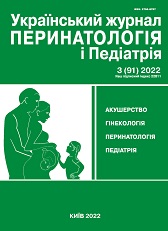Value of content analysis and verbal-communicative research method in studying the features of the course of acute respiratory disease novel COVID-19 in children
DOI:
https://doi.org/10.15574/PP.2022.91.35Keywords:
content analysis, verbal communication method, COVID-19, features of the course, childrenAbstract
The purpose - to study the peculiarities of the course of COVID-19 according to data of content analysis and the verbal-communicative method among children with SARS-CoV-2 infection.
Materials and methods. The study of features of the course of COVID-19 among children was carried out using two methods: content analysis of 54 medical records of inpatients and a verbal-communicative method by surveying 53 patients with further subsequent comparative evaluation of these methods. SARS-CoV-2 infection was diagnosed by an express method with the TESTSEALABS testing kit. Verification of SARS-CoV-2 infection was carried out by detection of SARS-CoV-2 RNA by PCR. The data of both methods included age, sex, epidemiological history, complaints, assessment of the general condition, clinical manifestations, forms of the course of the disease, etc.
Results. A comparative assessment of the two research methods showed that the verbal-communicative method, in comparison with the content analysis, made it possible to study in detail the features of the course of disease among children. In particular, the study found that the fever in most patients was remitting (significantly increased in the evening), lasting more than 5 days or more. Infants most often had pulmonary manifestations: cough, difficult breathing through the nose, shortness of breath at rest, fever, intermittent sucking of the breast or refusal of it, crying, restlessness; in isolated cases - febrile convulsions. In early and preschool age, in addition to pulmonary manifestations, the equivalent of anosmia/ageusia - “bad food” was detected; high frequency of gastrointestinal (abdominal pain, nausea, vomiting, acetonuria) and skin manifestations (covid cheilitis, injected sclera, papulo-vesicular rash, covid fingers). A milder course of the disease took place in junior and senior school age. In high school age, headache, musculoskeletal pain/ache, sore throat, hoarseness of voice, anosmia, ageusia were the most often noted - which resembled the course of COVID-19 in adults.
Conclusions. A comparative assessment of content analysis and the verbal communicative method confirmed that in medical practice, for the in-depth study of features of the course of COVID-19, these two methods should be used in combination as complementary and mutually clarifying.
The research was carried out in accordance with the principles of the Helsinki Declaration. The study protocol was approved by the Local Ethics Committee of the participating institution. The informed consent of the patient was obtained for conducting the studies.
No conflict of interests was declared by the authors.
References
Becker RC. (2020, Oct). COVID-19-associated vasculitis and vasculopathy. J Thromb Thrombolisis. 50 (3): 499-511. https://doi.org/10.1007/s11239-020-02230-4; PMid:32700024 PMCid:PMC7373848
Brodin P. (2020). Why is Covid-19 so mild in children? Acta Paediatr. 109 (6): 1082-1083. https://doi.org/10.1111/apa.15271; PMid:32212348
ECDC. (2020). European Centre for Disease Prevention and control. Rapid Risk Assessment. Paediatric inflammatory multisystem syndrome and SARS-CoV-2 infection in children - 15 May 2020. ECDC: Stockholm: 1-18. URL: https:www.ecdc.europa.eu.
Henderson NA, Canna SW, Friedman KG et al. (2020). American College of Rheumatology Clinical Guidance for Pediatric Patients with Multisystem Inflammatory Syndrome in Children (MIS-C) Associated with SARS-CoV-2 and Hiperinflammation in COVID-19. Version 2. Arthritis Reumatol. URL: htpps://onlinelibrary.willey.com/doi/10.1002/art41616. https://doi.org/10.1002/art.41454; PMid:32705809 PMCid:PMC7405113
Jackson DJ, Busse WW, Bacharier LB et al. (2020). Association of respiratory allergy, asthma, and expression of the SARS-CoV-2 receptor ACE2. J. Allergy Clin. Immunol. 146 (1): 203-206.e3. https://doi.org/10.1016/j.jaci.2020.04.009; PMid:32333915 PMCid:PMC7175851
Khodak LA, Ohienko VI, Bilokonova LA, Deineka NG. (2020). Features of the new coronavirus infection Covid-19 in children. Infectious diseases. 4 (10): 41-45. https://doi.org/10.11603/1681-2727.2020.4.11895
Lu X, Zhang L, Du H et al. (2020). SARS-CoV-2 infection in children. New England Jour. of Medicine. 382 (17): 1663-1665. https://doi.org/10.1056/NEJMc2005073; PMid:32187458 PMCid:PMC7121177
McGonaglea D, Sharita K, O'Regand A, Bridgewooda Ch. (2020). The role of cytokines including interleukin-6 in COVID-19 induced Pneumonia and Macrophage Activation Syndrome - Like Diseases. Pub.Med.gov. 19 (6): 102-537. https://doi.org/10.1016/j.autrev.2020.102537; PMid:32251717 PMCid:PMC7195002
Oshlyanska OA, Okhotnikova OM, Zakharchuk OV, Rusak SO. (2021). Multisystem inflammatory syndrome associated with SARS-CoV-2 infection in children: a new disease or a syndrome? On the example of a clinical case. Ukrainian Journal of Rheumatology. 2 (84): 1-10. doi: 10.32471/rheumatology2707-6970.84.16528.
Pidru4niki. (2022). Educational materials online. Content analysis as an expert diagnostic procedure. URL: https://pidru4niki.com.
Shchelkanov MYu, Polova AYu, Dedkov VG et al. (2020). History of study and modern classification of coronaviruses (Nidovirales: Coronaviride). Infection and immunity. 10 (2): 221-246. https://doi.org/10.15789/2220-7619-HOI-1412
Sorensen B, Dalgleish A, Susrud A. (2020, Jul 1). The Evidence which Suggests that is No Naturally Evolved Virus. A reconstructed Historical Aetiology of the SARS-CoV-2 Spike. Diovacc-19 in QRB. Immunor and St. George University of London. The Evidence No Nat. Oslo and London: 1-8. URL: htpps://minervanett.no. https://doi.org/10.1017/qrd.2020.8; PMid:34192262 PMCid:PMC7468800
Weblib. (2022). General characteristics of verbal and communicative research methods. 2016-2022. URL: http://weblib.pp.ua/verbalno-kommunikativnyie-metodyi-16049.html.
World Health Organization. (2022, Feb 8). Coronavirus Diseases (COVID-19): Situation Reports - WHO. URL: https:www.who.int>disease>situ.
Downloads
Published
Issue
Section
License
Copyright (c) 2022 Ukrainian Journal of Perinatology and Pediatrics

This work is licensed under a Creative Commons Attribution-NonCommercial 4.0 International License.
The policy of the Journal “Ukrainian Journal of Perinatology and Pediatrics” is compatible with the vast majority of funders' of open access and self-archiving policies. The journal provides immediate open access route being convinced that everyone – not only scientists - can benefit from research results, and publishes articles exclusively under open access distribution, with a Creative Commons Attribution-Noncommercial 4.0 international license(СС BY-NC).
Authors transfer the copyright to the Journal “MODERN PEDIATRICS. UKRAINE” when the manuscript is accepted for publication. Authors declare that this manuscript has not been published nor is under simultaneous consideration for publication elsewhere. After publication, the articles become freely available on-line to the public.
Readers have the right to use, distribute, and reproduce articles in any medium, provided the articles and the journal are properly cited.
The use of published materials for commercial purposes is strongly prohibited.

